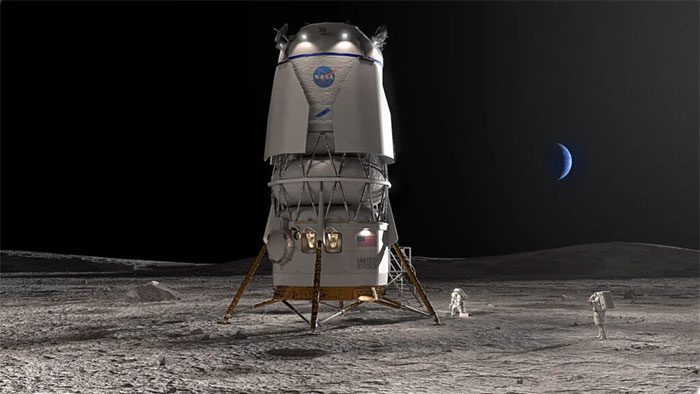On May 19, the National Aeronautics and Space Administration (NASA) signed a contract worth $3.4 billion with the space exploration company Blue Origin. Under this agreement, Blue Origin will design, test, and develop a lander for the Artemis 5 lunar exploration mission.

Rendering of Blue Origin’s Blue Moon lander, tasked with delivering astronauts to the lunar surface as part of the Artemis program. (Photo: AFP/TTXVN)
NASA Administrator Bill Nelson stated: “Today, we are excited to announce that Blue Origin – as NASA’s second provider – will build a system to help land astronauts on the lunar surface under the Artemis program. We are in a golden age of human spaceflight, made possible through NASA’s commercial and international partnerships. Together, we are investing in the infrastructure to pave the way for the first astronauts to set foot on Mars.”
According to the contract, Jeff Bezos’ company is tasked with transporting NASA astronauts to the Moon and then safely returning them to Earth. Initially, Blue Origin will conduct an uncrewed flight to the Moon to demonstrate the lander’s capabilities, followed by a crewed flight expected in 2029.
A small number of private companies, like Elon Musk’s SpaceX and Bezos’ Blue Origin, are striving to play a greater role in space exploration and competing for lucrative contracts from the U.S. government.
In April 2021, NASA signed a $2.89 billion contract with SpaceX to develop a lunar landing system to send two astronauts to the Moon as part of the Artemis 3 mission. Blue Origin also competed for this contract but was eliminated.
In 2022, NASA selected SpaceX again for the Artemis 4 mission while leaving the door open for other companies to enhance “competition.” This time, Blue Origin was given the opportunity.
Sharing on Twitter about this new milestone in collaboration, Bezos expressed that he is “honored to partner with NASA to send astronauts to the Moon.”
Under the plan, Blue Origin will collaborate with five other partners, including two defense contractors Lockheed Martin and Boeing, the spacecraft software company Draper, and two robotics firms, Astrobotic and Honeybee Robotics, to construct the Blue Moon lander, which will stand 16 meters tall.
While SpaceX’s Starship has a futuristic design, Blue Origin’s Blue Moon features a more classic appearance. Both companies’ landers are designed for reusability.


















































